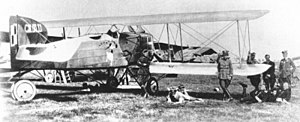Serangan Kiev (1920)
Serangan Kiev 1920 adalah upaya angkatan darat Republik Polandia Kedua yang dipimpin oleh Józef Piłsudski (yang bersekutu dengan pemimpin Ukraina Symon Petliura) untuk merebut wilayah Ukraina modern yang sempat dikuasai Uni Soviet setelah meletusnya Revolusi Bolshevik.[1] Tujuan spesifik operasi ini adalah mendirikan negara Ukraina yang merdeka.[2] Beberapa orang Ukraina menyambut pasukan Polandia,[3] walaupun ada pula yang bergabung dengan pihak Soviet.[4]
| ||||||||||||||||||||||||||||||
Operasi ini dimulai dari April hingga Juni 1920 dan ditentang oleh Soviet yang mengklaim sebagian besar wilayah Ukraina untuk negara RSS Ukraina.[4] Pasukan Polandia dan sekutu Ukrainanya pada awalnya berhasil merebut kota Kiev pada tanggal 7 Mei 1920, tetapi mereka lalu mulai mengalami kekalahan.[5] Serangan balasan Soviet lalu berhasil mengalahkan pasukan Polandia dan mereka kemudian mendirikan Republik Sosialis Soviet Galisia.[5]
Catatan kaki
sunting- ^ Encyclopædia Britannica, Russo-Polish War in Encyclopædia Britannica
[This war was a] military conflict between Soviet Russia and Poland, which sought to seize Ukraine […]Although there had been hostilities between the two countries during 1919, the conflict began when the Polish head of state Józef Pilsudski formed an alliance with the Ukrainian nationalist leader Symon Petlura (April 21, 1920) and their combined forces began to overrun Ukraine, occupying Kiev on May 7. - ^ "Although the [UNR] was unable to contribute real strength to the Polish offensive, it could offer a certain camouflage for the naked aggression involved. Warsaw had no difficulty in convincing the powerless Petliura to sign a treaty of alliance. In it he abandoned his claim of all territories [...] demanded by Pilsudski. In exchange the Poles recognized the sovereignty of the UNR on all territories which it claimed, including those within the Polish frontiers of 1772 – in other words, much of the area Poland demanded from Soviet Russia. Petlura also pledged not to conclude any international agreements against Poland and guaranteed full cultural rights to the Polish residents in Ukraine. Supplementary military and economic agreements subbordinate the Ukrainian army and economy to the control of Warsaw."
Richard K Debo, Survival and Consolidation: The Foreign Policy of Soviet Russia, 1918–1921, pp. 210–211, McGill-Queen's Press, 1992, ISBN 0-7735-0828-7. - ^ Davies, Norman (1996). Europe: A History. Oxford: Oxford University Press. hlm. 935. ISBN 0-19-820171-0.
- ^ a b Peter Abbot."Ukrainian Armies 1914–55", Chapter "Ukrainian Soviet Socialist Republic, 1917–21[pranala nonaktif permanen]", Osprey, 2004, ISBN 1-84176-668-2
- ^ a b Magocsi, Paul Robert (1996). A History of Ukraine. Toronto: University of Toronto Press. hlm. 534. ISBN 0-8020-0830-5.
